How I dealt with an escaped rhino and a bored tapir in Planet Zoo
Hands-on with Frontier's wild new zoo sim.
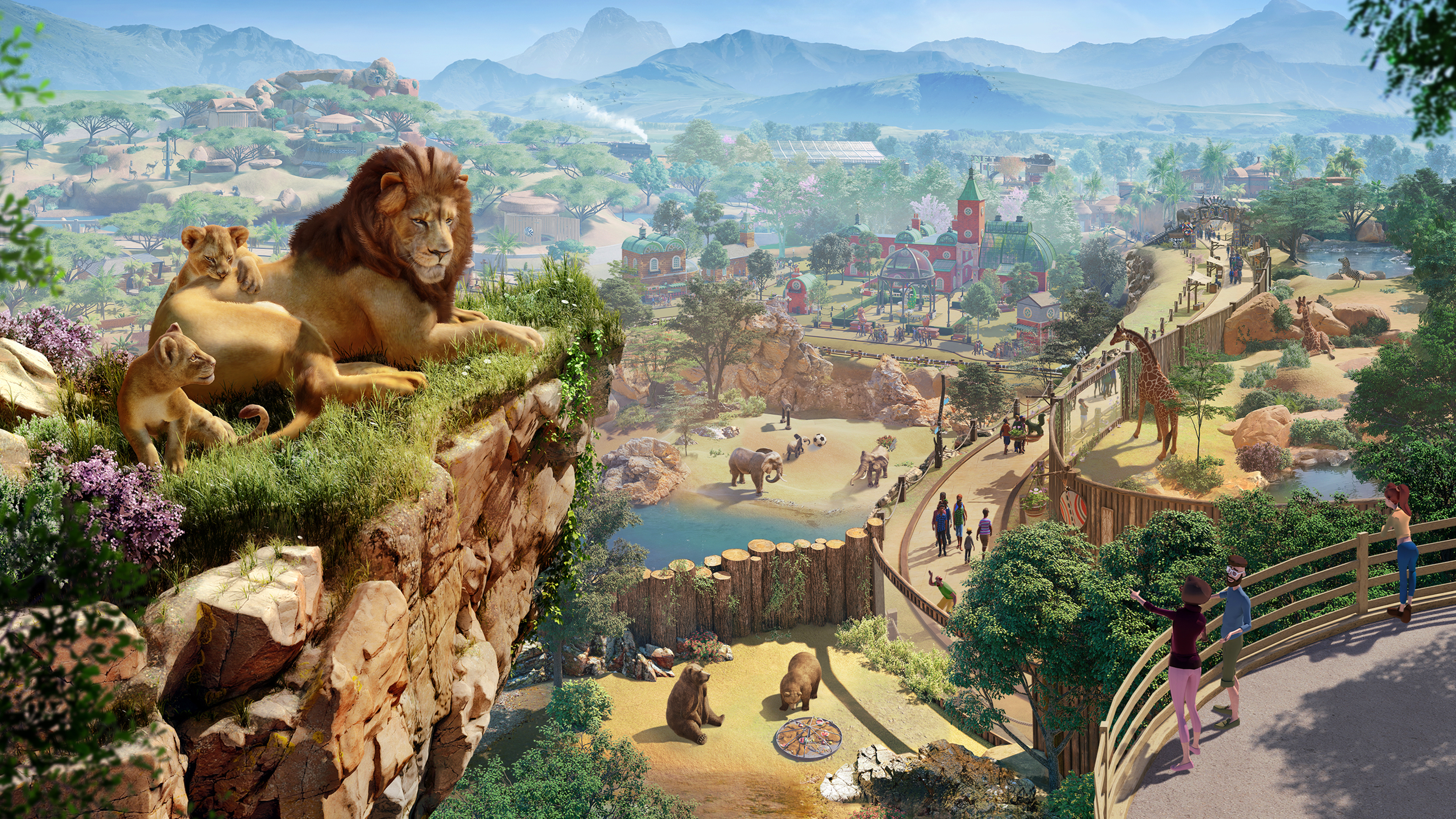
Swinging the camera over my zoo, I watch throngs of people wander between enclosures, happily cooing at the animals and slurping soda. But then there's a ripple of panic. I see several guests fleeing in terror, and the fear starts to spread. Something is happening in my perfect zoo. I heave the camera into the air and locate the source of the rumble: an escaped rhinoceros.
Rhinos are dangerous animals, but it's lucky for my guests that Planet Zoo is a family friendly game. In Frontier's more monstrous park builder, Jurassic World Evolution, an escaped animal usually leads to people being eaten alive. But here it just makes them upset, which in terms of running and managing a successful (and profitable) zoo is still bad news. So the first job in this, my inaugural hands-on with Planet Zoo, is dealing with a breakout.
My zoo isn't as perfect as I thought it was, because I'm currently experiencing a severe shortage of vets—a vital member of staff whose jobs include tranquillising escaped animals and returning them safely to their enclosures. I bring up the staff menu, click on the veterinarian button, and drop one directly into the park. It's that easy. More experienced vets demand higher wages, which is one of countless management decisions you'll have to make as you play Planet Zoo. I decide to splash out on a pro to get the job done swiftly.
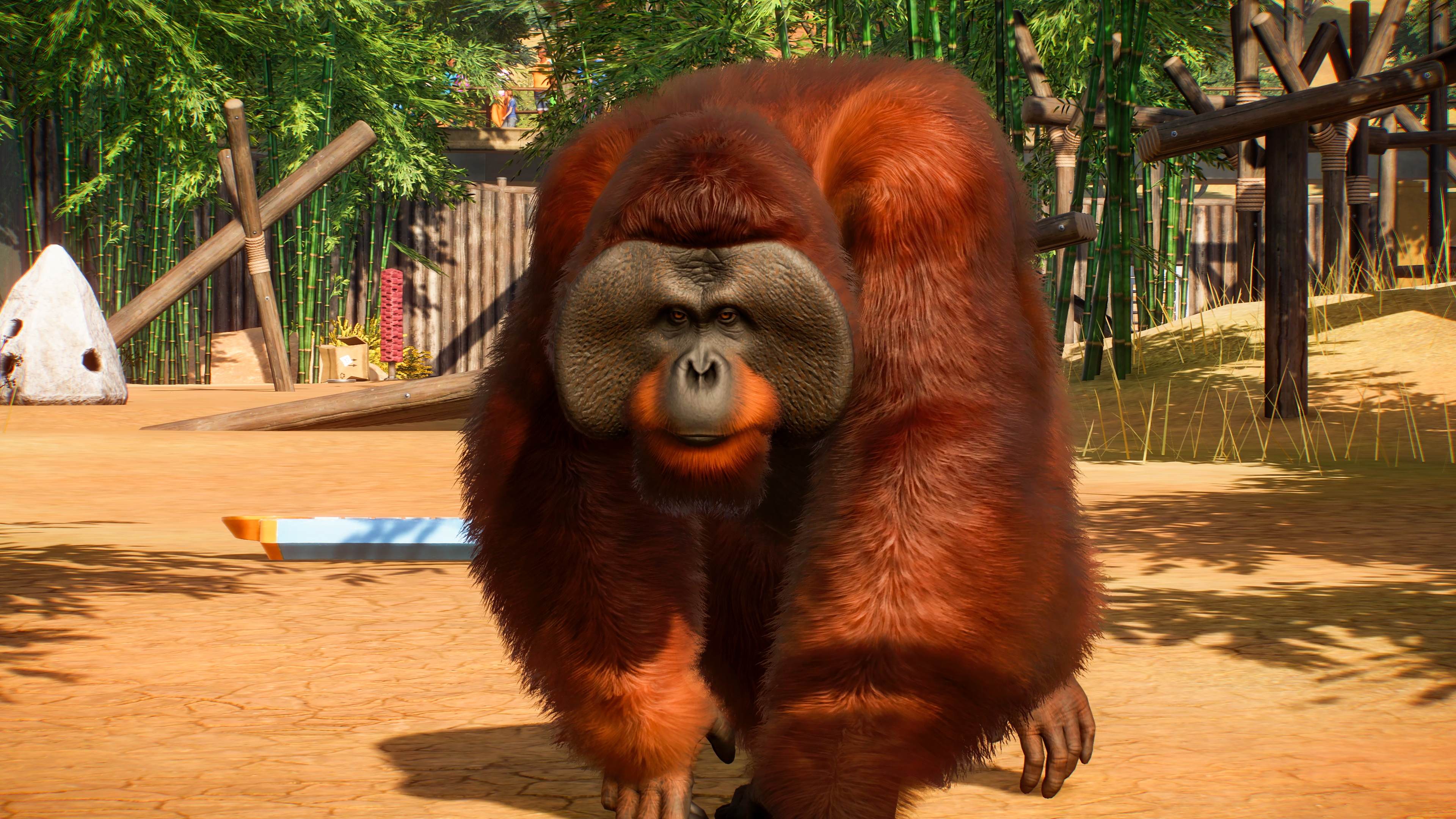
I plop my veteran veterinarian near the escaped rhinoceros and he immediately springs to action. He pulls out a tranq rifle with a scope and launches a dart into the beast's thick hide. She tries to run away, but it's too late. The tranquilliser kicks in and she slumps into a heap on the ground. The vet seals her in a crate, which magically shrinks to a size he can hold, then he automatically drops it off in the enclosure that was previously assigned to the animal. But before I can release her I need to find out how exactly she escaped.
Surveying the enclosure, it's fairly obvious how it happened: there's a gaping hole in the electric fence surrounding it. I click on the existing fencing and I'm able to easily rebuild it by simply dragging my mouse cursor across the gap to fill it. Happy that all the holes have been plugged, I click on the crate and release the rhino back into her enclosure. Disaster averted. The guests, clearly over their trauma, flock to the area to marvel at the newly rehoused rhino.
And I understand why they're so impressed. I double click on the rhino to activate the animal camera, which lets me admire Planet Zoo's remarkable creatures up close. As she lumbers around the enclosure there's a genuine sense of weight and presence. She really feels like a living thing, swinging her tail, flicking her ears, and sniffing the air. Planet Zoo's animators watched thousands of hours of nature documentaries, and it shows. You're gonna spend a lot of time watching your animals with this camera mode.
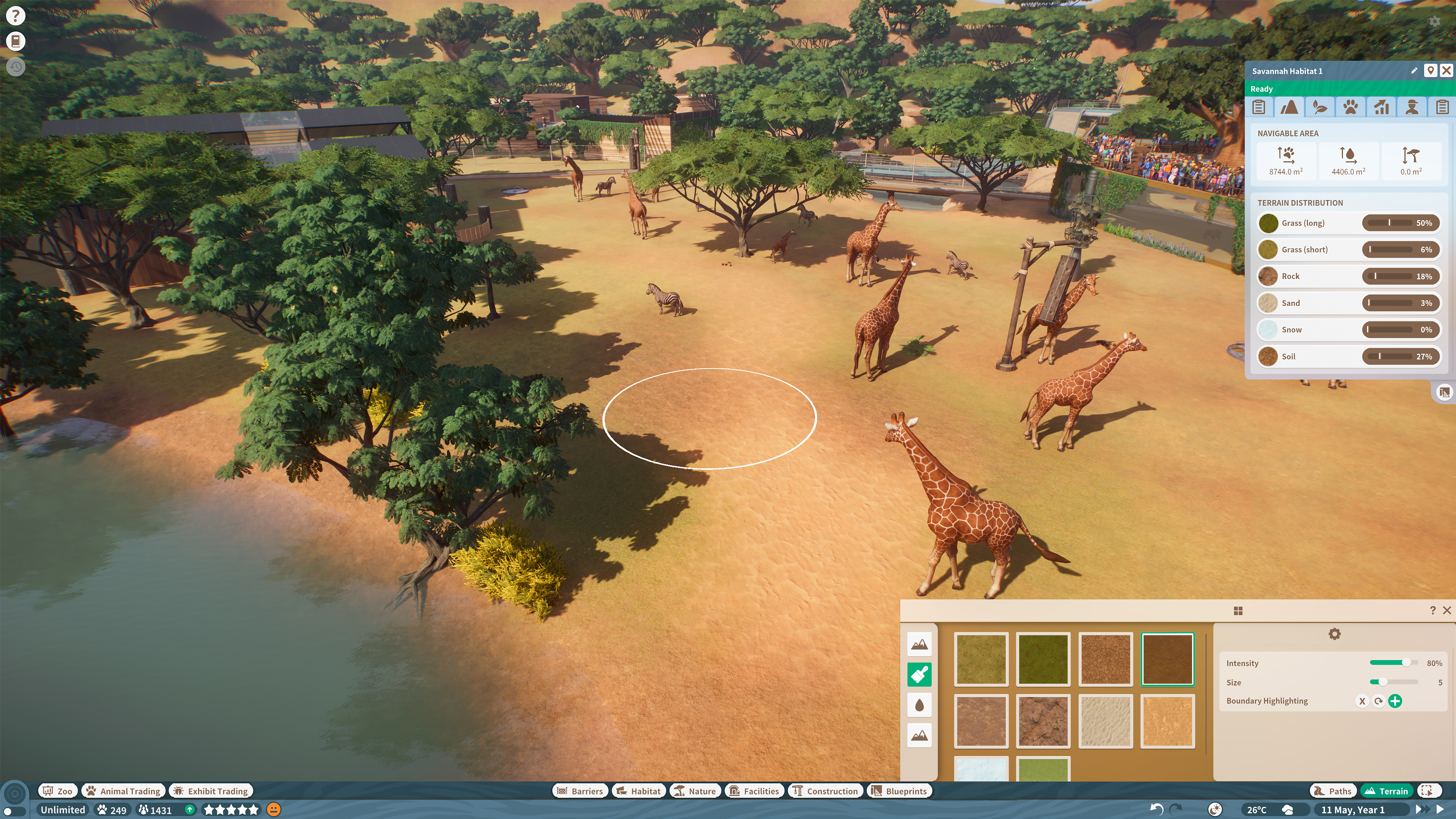
Alas, I can't spend all day hanging out with the rhinos because I have more problems to solve. I drag the camera over to another enclosure and see a herd of pronghorn antelope wandering around a lifeless, dusty field. I click on one, a female called Maple, and notice that the 'habitat' meter on her welfare tab is dangerously low. Animal welfare is one of the most important things in Planet Zoo and the quality of their enclosure is a big part of that.
The biggest gaming news, reviews and hardware deals
Keep up to date with the most important stories and the best deals, as picked by the PC Gamer team.
Luckily I can see at a glance what I need to do to make this space more pleasant for the antelope. A series of meters tells me that I have plenty of sand, but I need more grass, soil, and rock to balance it out. Every species in Planet Zoo has a particular type of terrain it feels comfortable in, which you'll have to cater to if you want them to lead long, happy, and fulfilling lives. I click on the terrain painting tool and begin, well, painting the enclosure. I sprinkle some grass here, some rock there, and watch the welfare meter edge up.
Some animals like snow and you can paint it in your enclosure as easily as grass. But in a hot climate it won't stick unless you use a device called a cooler, which stops it from melting. But back to those pronghorn antelope, which seem much happier now that I've improved their enclosure. I activate the animal camera again and spin it around them, admiring their incredibly fluffy butts. The fur technology in Planet Zoo is really impressive up close.
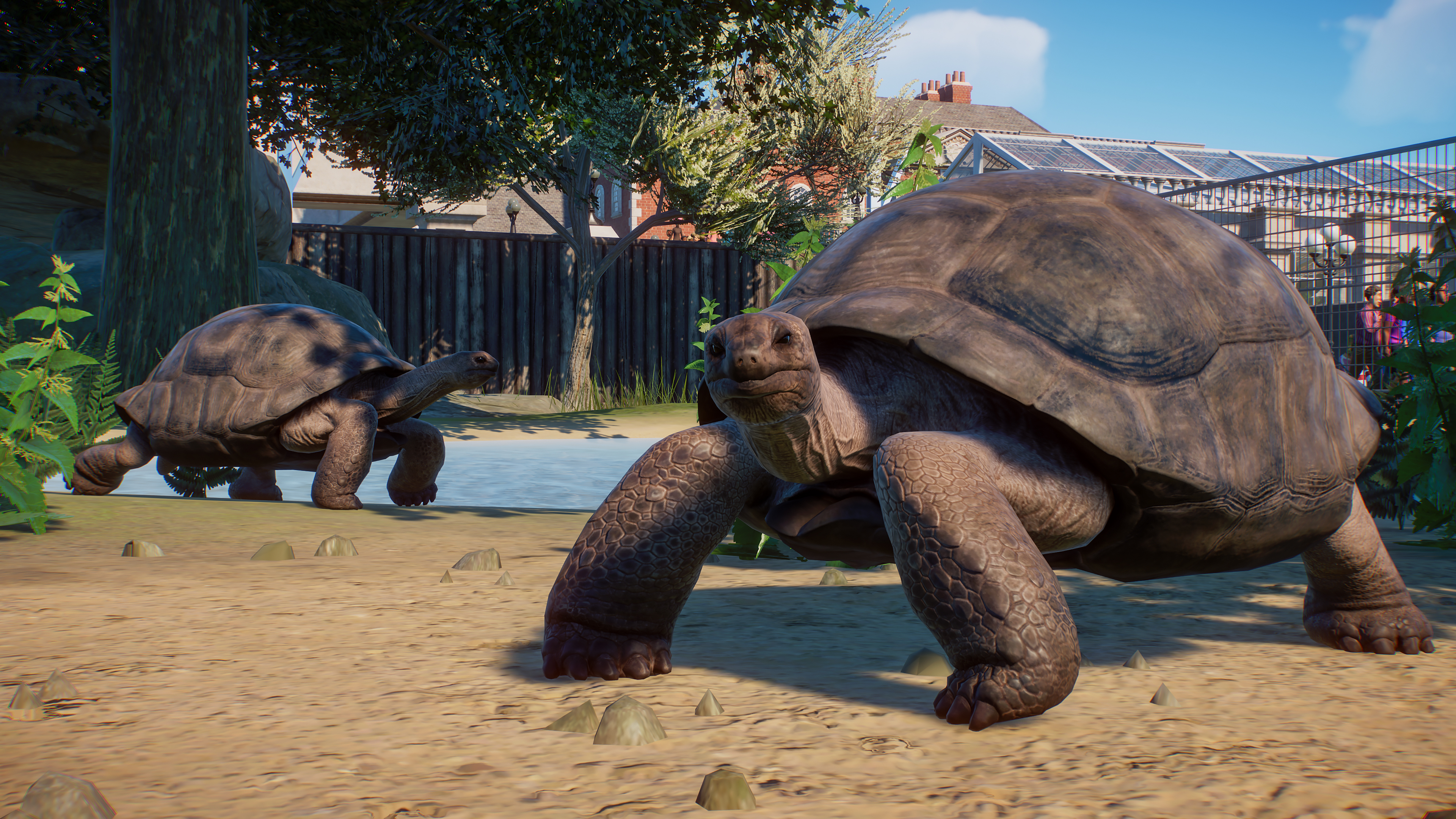
Now I have some tapirs to deal with. Their habitat is fine, with just the right balance of terrain, but they're bored. This is because I haven't placed any enrichment items: toys, feeders, and other distractions designed to keep the animals in your zoo mentally stimulated. I bring up a build menu containing the game's vast collection of enrichment items, but the tapirs will only engage with some of them. Luckily, however, I can filter it by species.
Tapirs are natural foragers, so I drop a foraging box. They can snuffle around in here and dig out food, which will have a positive impact on their well-being. I also drop a barrel feeder, which they can stick their snouts in, and a rubbing pad for them to have a lil scratch on. You can place these objects anywhere, but the best location is always near a viewing platform or window. This means your guests will get some enjoyment out of them too.
I'm not done yet, though. A need specific to some species, including my tapirs, is 'coverage', which is increased by filling an enclosure with plants and trees. Some animals, like the pronghorn antelope from earlier, prefer open spaces, but the tapirs like being surrounded by foliage. Clicking on the nature menu I'm presented with an enormous selection of plant life, and I litter the tapir enclosure with monkey puzzle trees and lobster claw plants: species native to the hot South/Central American climate my zoo is currently situated in.
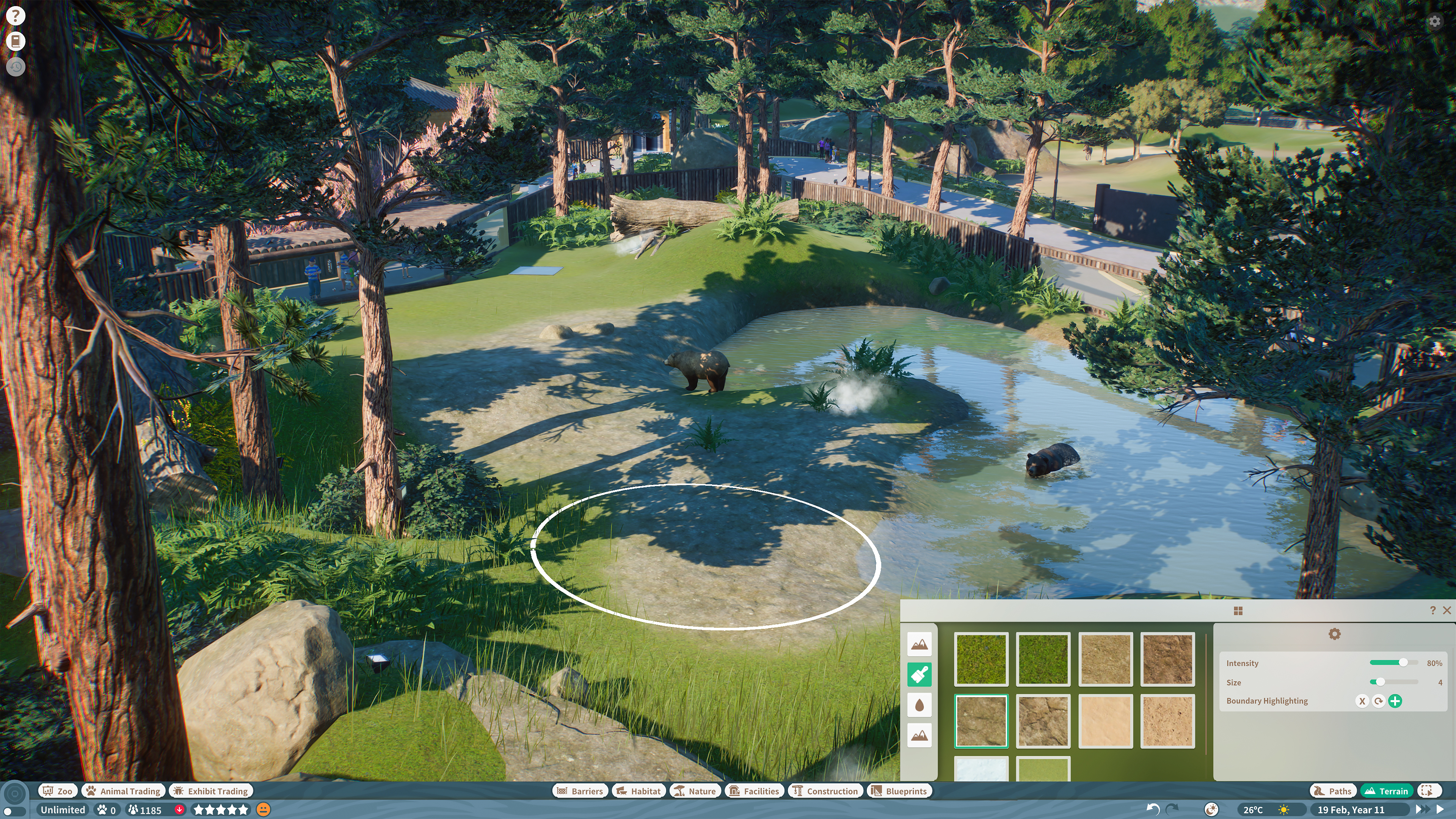
But there are, of course, more plates to spin. But compared to some management games, such as the frenetic Two Point Hospital, the plates in Planet Zoo spin quite slowly. My next job is cleaning my crocodile's enclosure—specifically the water, which has turned a rather disgusting shade of brown. Not only is this bad for the animal, but it obscures the guests' view. I switch to a heat-map that shows me the water quality, and it's currently blazing a dangerous-looking red, illustrating that sorting this out is a priority.
I select a water treatment facility from the build menu, and it's as easy as dropping it in the vicinity of the water to clean it. But there's a layer of strategy to this, because guests will be unhappy if they see the pumps churning away. So you'll have to place it in a way that's accessible to staff, by being connected to a path, but also hidden away. You could build a wall around it, perhaps. Or just obscure it with a scattering of foliage. Out of sight, out of mind. It doesn't take much to upset the roving herds of guests lining the pathways of Planet Zoo, which means you're constantly battling to keep them happy.
The water clears and my croc goes for a swim. A crowd of guests watch excitedly through the glass, and nearby is a screen that gives them information about what they're seeing. The more research you do, the more info appears here, increasing the educational potential of your zoo. Reflecting modern zoos, Planet Zoo is all about understanding animals and looking after them, rather than just thinking of them as commodities to be exploited.
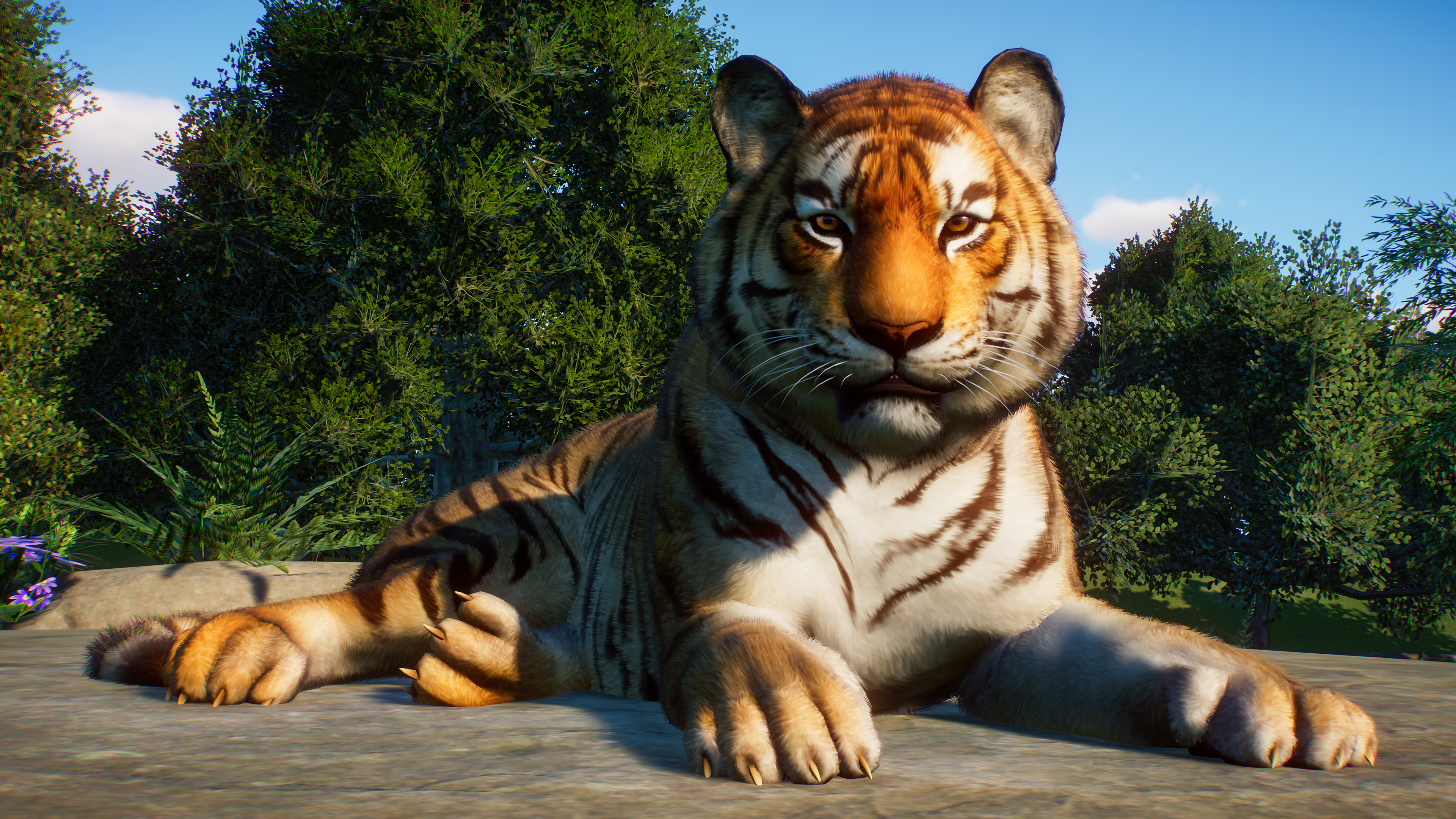
Finally, I get a taste of what it's like to invite a new animal to the zoo. I spend $15,000 on a magnificent Bengal tiger named Farhan, who I discover is a rescue animal. An animal's upbringing, as well as other factors, will affect their size, longevity, fertility, and immunity to disease. Farhan has a 100% rating for size, but only 33% for immunity, meaning he might get sick easily. But when I drop him into my zoo the guests love him. He's a natural at this.
It's clear this demo was set up to give me a taste of a bunch of different game systems in one sitting, but even in this slightly artificial environment I can tell that I'm going to lose hours of my life to Planet Zoo. It combines the deep, freeform, expressive building of Planet Coaster with some really quite remarkable animals. They move, act, look, and sound just like the real thing, and taking care of them has a lot of interesting, engaging layers of strategy, not to mention managing budgets, building the zoo itself, and more besides. This could be one of Frontier's greatest park builders to date.
If it’s set in space, Andy will probably write about it. He loves sci-fi, adventure games, taking screenshots, Twin Peaks, weird sims, Alien: Isolation, and anything with a good story.


